One of the most challenging aspects of the response to COVID-19 is the lack of information known about the virus before it started to spread throughout the world. How is the virus transmitted? What demographic does it impact the most? Is someone immune to the disease once they have had it? Research continues on most of these questions. However, five months into the pandemic here in the U.S., more data is available to help the public and health officials understand the virus.
Widely available data is crucial to formulate a response to the pandemic. Because very little was known about the virus before it began to spread, informing the public and making instructive data available for people to make informed decisions is essential. Elected officials are making decisions that affect livelihoods, and the public deserves to know the metrics used to make these decisions. The Cooper administration’s unwillingness to provide the full datasets led a coalition of newsrooms to sue over the release of critical data.
More information about the specific cases of coronavirus is necessary as we look forward to reopening schools and businesses and resuming pre-pandemic life. The public needs this information to make the best-informed decisions for themselves and their families. FAIR Health, a non-profit research organization with a repository of over 30 billion claims, released a recent study that reveals some of the key characteristics of patients who test positive for COVID-19.
John Locke Foundation’s readers may be familiar with FAIR Health studies. I recently used two of its previous studies for a multi-part research update series on supply and demand shock in health care regarding hospitals and non-hospital providers. This research update will synthesize the results from the latest FAIR Health study, which uses private health insurance claims from January to May of 2020 to detail the profiles of patients who tested positive for the coronavirus, nationally.
Age
The first characteristic the study looks at is age. This measure is particularly important as the debate continues about how to reopen schools this fall.
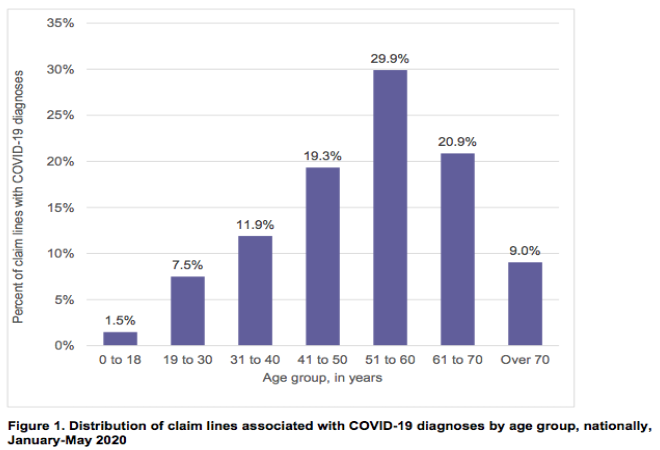
Nearly 60 percent of positive coronavirus cases occurred among those who are older than 51. This is consistent with what we knew about the virus from other countries. Those who are older and more likely to be in poorer health are more likely to contract the virus. Individuals between the ages of 51 and 60 fare the worst for positive diagnoses. Almost 30 percent of positive cases are among those in this age group.
Gender
The likelihood of contracting the disease by gender is another important data point. The below chart shows the breakdown of positive COVID-19 cases by gender.
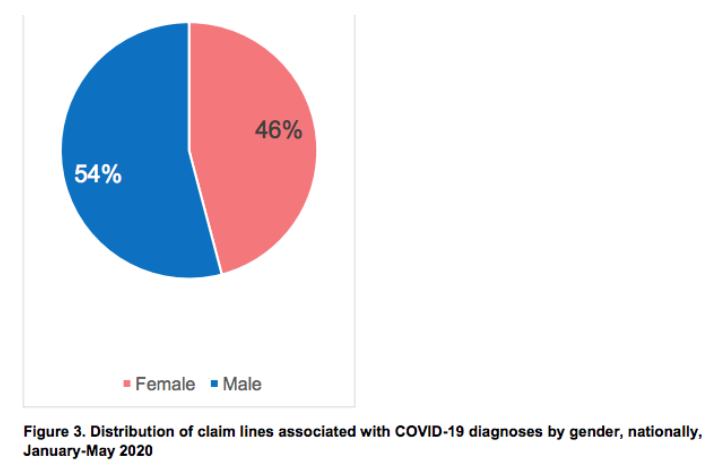
Males accounted for 54 percent of the claim lines, while females account for 46 percent. Most studies have concluded males and females have an equal chance of contracting the disease. However, this FAIR Health study, based on private insurance claims, reveals that males may have a higher chance of infection.
Rural vs. Urban
Rural vs. urban data reveals where the pandemic has hit the hardest. During the beginning of the pandemic in the U.S., large metropolitan cities such as New York, Los Angeles, and Detroit were the hardest hit. As the virus continued to spread after the first few months, rural communities in the South and Midwest began to see an uptick in cases. What was originally a virus surging through large cities eventually spread to more rural areas.
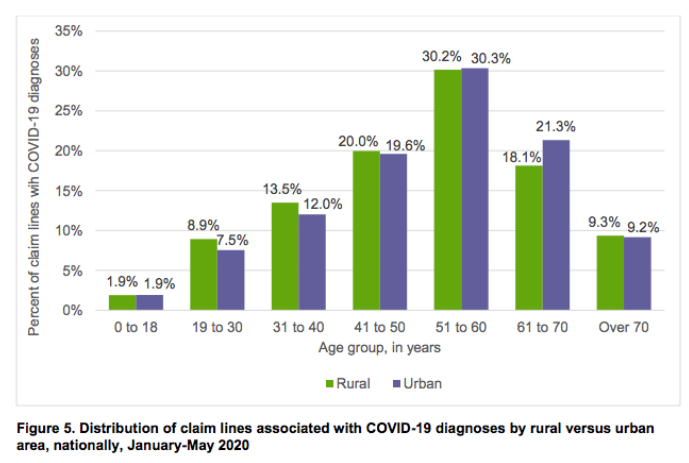
The chart above breaks down the COVID-19 cases by age group and compares rural versus urban populations for each. The 0 to 18, 41 to 50, 51 to 60, and over 70 age ranges each had a similar number of positive patients between rural and urban demographics. In the 19 to 30 and 31 to 40 age range, there were more individuals in rural areas who contracted coronavirus. This is likely since those living in rural areas typically have worse health outcomes than their urban counterparts. In the 61 to 70 age range, the urban population saw more positive COVID-19 cases than the rural areas. This was likely due to the severity of the virus in the more urban areas, and the fact that those who are older are far more likely to contract the disease.
Venue of Care
The next metric collected by FAIR Health for this study was the venue of care in which patients with COVID-19 were diagnosed. These data reveal the location of care in which the patient tested positive for coronavirus.
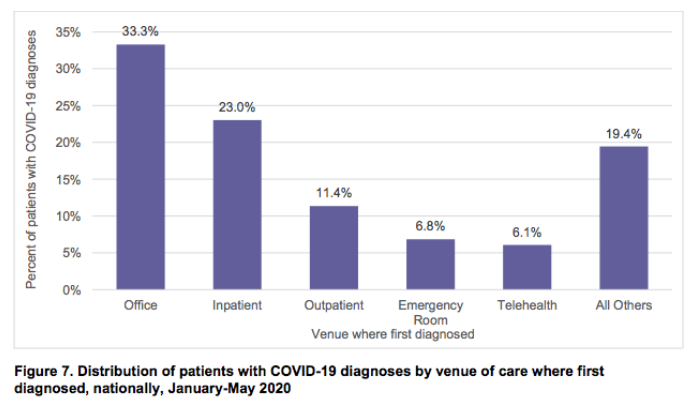
Hospitals have been the frontline venue for treating and diagnosing COVID-19 patients. Yet in this study, the claims data shows that doctors’ offices were the primary place in which patients went to receive tests that came back positive. Inpatient and outpatient settings were the next two most common venues. This makes sense as the hospitals have been the primary place for treating COVID-19 patients when the symptoms become severe. The emergency room and telehealth measures were the next two most common venues. Telehealth triage was particularly helpful in helping patients decide whether they needed to come into the facility for further treatment as those giving the diagnosis could listen to the self-reported symptoms and provide information in real-time. The final category of “all others” contains diagnoses that happened in a laboratory, urgent care center, or ambulance.
Comorbidities
Data concerning the comorbidities and other preexisting conditions of COVID-19 positive patients is one of the most important pieces of information about the virus. These data explain which conditions are more likely to predispose someone to COVID-19. We know that the virus doesn’t affect all individuals the same way. The North Carolina Senate added a comorbidities data requirement to the coronavirus relief package, but it did not end up in the final bill.
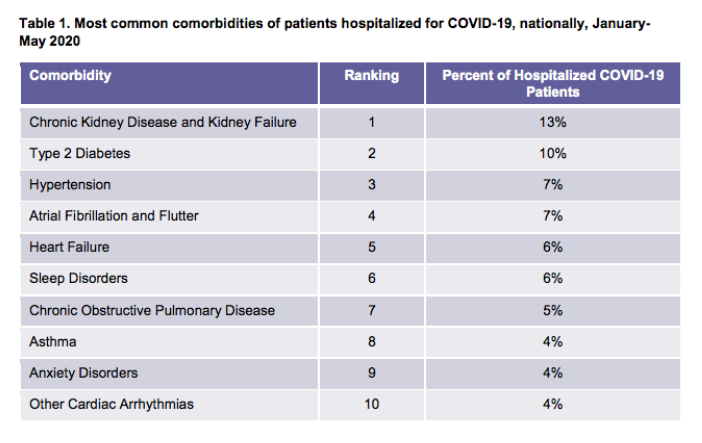
Chronic kidney disease and type 2 diabetes were the most common comorbidities among those who tested positive for COVID-19. Other conditions, such as hypertension, atrial fibrillation, and heart failure, were other common conditions.
Costs
The cost of care for those who test positive for COVID-19 has been one of the main points of debate during this pandemic. Who pays for testing? Who pays for the treatment? What about those who are uninsured? I discussed the answer to these questions in a previous research update.
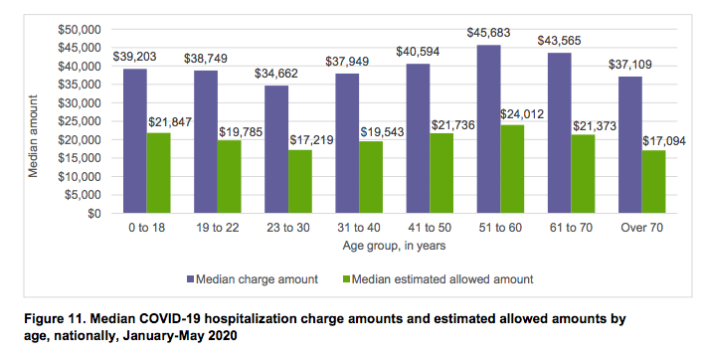
The chart above details two costs for COVID-19 hospitalizations for each age range used in this study. The median charge amount indicates what the hospital would charge an uninsured patient or a patient seeking out of network care (think chargemaster price). The median estimated allowed amount is the negotiated fee agreed to by a hospital and an insurer. This includes both the insurer and the patient’s contribution. For someone who is uninsured or seeking out of network care, the charge ranges from $34,662 for the 23 to 30 age range to $45,683 for the 51 to 60 age range. For the median allowed amount for those seeking in-network care, the charges ranged from $17,219 for the 23 to 30 age group to $24,012 for the 51 to 60 age group.
Here is one final note on the payment of care regarding uninsured patients. Through the Provider Relief Fund set up under the CARES Act, the Trump administration set up a fund to pay hospitals and other providers who treated uninsured COVID-19 patients. In a recent report from Medscape, a senior U.S. Health and Human Services official revealed there had been far fewer claims submitted to the uninsured portal than previously expected.
The FAIR Health study used to inform this research brief helps identify some of the characteristics of COVID-19 patients. With a new virus such as COVID-19, the public and health officials are working on the fly to understand the demographics that should be prioritized and make public policy recommendations accordingly. At the same time, we know now that the virus does not affect one demographic. exclusively. Hopefully, governments disseminate as much coronavirus data as possible to keep the public informed and allow everyone to assess their own risk.
Note: Source for all charts in this piece originally appeared in Key Characteristics of COVID-19 Patients: Profiles Based on Analysis of Private Healthcare Claims, July 14, 2020.


